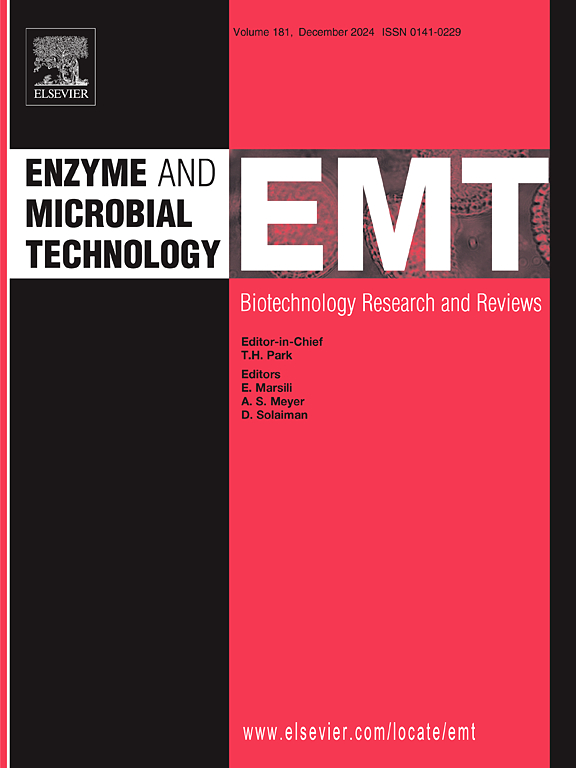Ethyl lactate synthesis in organic media using a magnetic supported CALB
IF 3.7
3区 生物学
Q2 BIOTECHNOLOGY & APPLIED MICROBIOLOGY
引用次数: 0
Abstract
The growing demand for sustainable chemical processes has spurred interest in enzymatic synthesis, particularly for valuable compounds like ethyl lactate. Traditional chemical methods often suffer from drawbacks, highlighting the potential of enzymatic catalysis using immobilized lipases. This study evaluated the performance of magnetic biocatalyst, prepared by immobilizing Candida antarctica lipase B (CALB) on magnetic nanoparticles, for the batch synthesis of ethyl lactate in hexane. Initial experiments using free CALB and commercial Novozym435 proved problematic due to enzyme denaturation and support instability, respectively. While titration-based methods for monitoring the reaction were found to be unreliable due to lactic acid's complex behavior in the reaction medium, titratable acidity reduction suggested an optimal lactic acid to ethanol molar ratio of 1/10. Subsequent HPLC analysis revealed that the magnetic biocatalyst maintained a consistent conversion (%) at higher lactic acid concentrations (up to 17 mg/mL at 45°C, with conversion above 60 % in 5 h), demonstrating its potential for processing larger amounts of substrate. The initial reaction rate was estimated to be 3.8 mM/h. The study also identified experimental challenges in accurate lactic acid quantification and potential catalyst degradation. In conclusion, the magnetic CALB biocatalyst shows promising activity and stability for ethyl lactate synthesis, especially at higher substrate loads, paving the way for further optimization and application in sustainable production.
磁性负载CALB在有机介质中合成乳酸乙酯
对可持续化学过程日益增长的需求激发了人们对酶合成的兴趣,特别是对有价值的化合物,如乳酸乙酯。传统的化学方法往往遭受的缺点,突出潜力的酶催化使用固定化脂肪酶。研究了磁性纳米颗粒固定化南极念珠菌脂肪酶B (CALB)制备的磁性生物催化剂在正己烷中批量合成乳酸乙酯的性能。使用游离CALB和商用Novozym435进行的初步实验分别证明由于酶变性和支持不稳定性而存在问题。由于乳酸在反应介质中的复杂行为,基于滴定的反应监测方法被认为是不可靠的,可滴定的酸度还原表明乳酸与乙醇的最佳摩尔比为1/10。随后的HPLC分析显示,磁性生物催化剂在较高的乳酸浓度下保持一致的转化率(%)(在45°C下高达17 mg/mL,转化率在5 h内超过60 %),表明其处理大量底物的潜力。初始反应速率估计为3.8 mM/h。该研究还确定了准确乳酸定量和潜在催化剂降解的实验挑战。综上所述,磁性CALB生物催化剂在乳酸乙酯合成中表现出良好的活性和稳定性,特别是在高底物负荷下,为进一步优化和可持续生产应用铺平了道路。
本文章由计算机程序翻译,如有差异,请以英文原文为准。
求助全文
约1分钟内获得全文
求助全文
来源期刊

Enzyme and Microbial Technology
生物-生物工程与应用微生物
CiteScore
7.60
自引率
5.90%
发文量
142
审稿时长
38 days
期刊介绍:
Enzyme and Microbial Technology is an international, peer-reviewed journal publishing original research and reviews, of biotechnological significance and novelty, on basic and applied aspects of the science and technology of processes involving the use of enzymes, micro-organisms, animal cells and plant cells.
We especially encourage submissions on:
Biocatalysis and the use of Directed Evolution in Synthetic Biology and Biotechnology
Biotechnological Production of New Bioactive Molecules, Biomaterials, Biopharmaceuticals, and Biofuels
New Imaging Techniques and Biosensors, especially as applicable to Healthcare and Systems Biology
New Biotechnological Approaches in Genomics, Proteomics and Metabolomics
Metabolic Engineering, Biomolecular Engineering and Nanobiotechnology
Manuscripts which report isolation, purification, immobilization or utilization of organisms or enzymes which are already well-described in the literature are not suitable for publication in EMT, unless their primary purpose is to report significant new findings or approaches which are of broad biotechnological importance. Similarly, manuscripts which report optimization studies on well-established processes are inappropriate. EMT does not accept papers dealing with mathematical modeling unless they report significant, new experimental data.
 求助内容:
求助内容: 应助结果提醒方式:
应助结果提醒方式:


